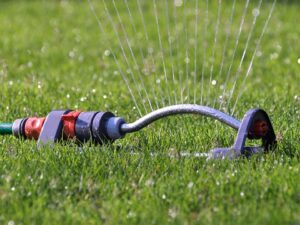Best Lawn Watering Tips

There are many maintenance practices that go into a beautifully maintained lawn, water management being one of those practices that’s so crucial for a lawn to thrive. I have seen lawns that were so badly neglected becoming an eyesore because of a lack of water and other maintenance issues. Lawns are living and breathing and therefore require not just water but the right amount of water to grow healthy.
Just as a lack of water is damaging to a lawn so is overwatering, there is a misunderstanding among many homeowners about the amount of water a lawn should receive. Well, today we will be addressing this question and more about how much water your lawn should be receiving and when is the best time to water your lawn to promote healthy growth
When is the Best Time to Water Your Lawn?
The ideal time to water your lawn is during the morning hours between 6 am – 9 am and again depending on the weather and the condition of your lawn at 4 pm-6 pm. Watering too late in the evening will cause the lawn not to dry out in time before nightfall which can lead to disease.
Signs that Your Lawn Needs Water
- If your lawn has patchy spots that may indicate your lawn is crying for water, these patches may appear brown or yellow. Other factors may be at work here as well but a lack of water is one of the main cause
- Your grass turns from a vibrant rich green to a dull, bluish-gray color
- If the soil is dry and crumbles is a sure sign that your grass needs a drink of water
- Another sign that your grass needs water is its slow growth
- If footprints or other tracks linger in the grass long after they have been made
- Some of the blades start to wilt
Signs that Your Lawn is getting Too Much Water
- Just as a lack of water can encourage weeds so overwatering can do the seem also
- A bug infestation may be an indication of a water-saturated lawn
- If your lawn feels spongy or squishy when you step on it is a sign that you may be giving your lawn too much water
- If you notice water running off your lawn and into a plant bed nearby or down the street is a clear sign you’re overwatering
- Mushroom-looking plants that emerge from your lawn are an indication that your lawn is getting too much water. These lawn mushrooms are fungi that can cause your lawn to fall back
- While a bit of thatch can benefit lawns a great build-up of thatch is a sign the lawn is being overwatered
How Much Water?
The goal when applying water to your lawn is to ensure that the top first 6 to 8 inches of soil is wet. This few inches of soil is basically where most turf grass roots grow. To put it another way, a lawn should receive about an inch of water per week, applying water daily can result in a lawn with a shallow root system.
A shallow root system will dry out faster which will weaken your lawn, deep watering however will promote healthy growth which will encourage grassroots to run deep and become strong and disease resistant.
Signs that Your Lawn has Sufficient Water
Lawns that are well-watered (the right amount of water) will have a healthy appearance with rich green color, and the grass blades will remain erect.
Adding a Sprinkler System

Lawns can be watered manually or automatically, manually watering lawns however is labor intensive and you may stand the risk of not getting equal coverage. Besides, if a lawn is too large may present other issues with manual watering, installing a sprinkler system will help greatly.
These automatic systems can be placed on a timer and provide not only the right amount of water but proper coverage as well. The other side of the coin, however, is based on the size of the area and along with the design of the sprinkler system may be pretty expensive to install, and then there is also the maintenance that goes into these systems.
There are sprinklers that can be attached to a garden hose which is affordable and can be purchased from your hardware store or garden center. These sprinklers come in many shapes and sizes and are best to use on small lawns, automatic sprinklers are better fitted for medium or large lawns. If your lawn is too large to water manually then your best choice would be to have an automatic sprinkler system installed. Like I said these systems can be pretty costly to install so shop around to find a professional lawn care company that will work with your budget.
Watering Different Lawn Types
When it comes to watering lawns it’s not one size fits all, there are 2 different grass types cool-season and warm season.
Warm-season grasses- warm-season grasses thrive in temperatures that are above 80 degrees, these grass types slow down when the daytime temperature starts to drop. Ensure that your grass maintains its moisture to thrive, as long as warm-season grass is growing and mowed continue to water. The ideal time to fertilize warm-season grasses is during springtime when the grass is actively growing. Once fertilizers have been applied wash fertilizers off the grass blades and into the soil.
Cool-season grasses- During the fall season cool-season grasses are actively growing, these grass types need an inch to an inch and a half of water every week. Once the winter months set in decrease watering. Cool-season grasses can also be fertilized during the fall months, Once fertilizers have been applied wash fertilizers off the grass blades and into the soil.
A Bonus Point Just for You
1. A lawn that lacks water may also show the same symptoms as a lawn that is overwatered so it’s best to check the soil’s moisture level before applying water.
2. The Average lawn needs to be watered 3 times per week.
The final word on the best time to water your Lawn
Our lawns are living and breathing, we should do all that we can to ensure they continue to thrive and look their best. Knowing good water management will not only help in the survival of a lawn but will help (water wastage) to save on that water bill so it’s a win-win for both you and your lawn which I think is a good trade-off.
About the author
Norman loves being in the garden, both at home and for his job....
he is 'Natures Little helper' being outdoors, growing his vegetables and flowers from an early age.
Now having spent over 22 years in the profession he want to give some of his knowledge to others...
his vast array of hints and tips you will find scattered over this site will help you no end growing plants in your garden.
